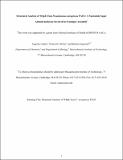Structural Analysis of WbpE from Pseudomonas aeruginosa PAO1: A Nucleotide Sugar Aminotransferase Involved in O-antigen Assembly
Author(s)
Larkin, Angelyn; Olivier, Nelson B.; Imperiali, Barbara
DownloadImperiali8_Larkin_Biochem_2010.pdf (9.560Mb)
PUBLISHER_POLICY
Publisher Policy
Article is made available in accordance with the publisher's policy and may be subject to US copyright law. Please refer to the publisher's site for terms of use.
Terms of use
Metadata
Show full item recordAbstract
In recent years, the opportunistic pathogen Pseudomonas aeruginosa has emerged as a major source of hospital-acquired infections. Effective treatment has proven increasingly difficult due to the spread of multidrug resistant strains and thus requires a deeper understanding of the biochemical mechanisms of pathogenicity. The central carbohydrate of the P. aeruginosa PAO1 (O5) B-band O-antigen, ManNAc(3NAc)A, has been shown to be critical for virulence and is produced in a stepwise manner by five enzymes in the Wbp pathway (WbpA, WbpB, WbpE, WbpD, and WbpI). Herein, we present the crystal structure of the aminotransferase WbpE from P. aeruginosa PAO1 in complex with the cofactor pyridoxal 5′-phosphate (PLP) and product UDP-GlcNAc(3NH2)A as the external aldimine at 1.9 Å resolution. We also report the structures of WbpE in complex with PMP alone as well as the PLP internal aldimine and show that the dimeric structure of WbpE observed in the crystal structure is confirmed by analytical ultracentrifugation. Analysis of these structures reveals that the active site of the enzyme is composed of residues from both subunits. In particular, we show that a key residue (Arg229), which has previously been implicated in direct interactions with the α-carboxylate moiety of α-ketoglutarate, is also uniquely positioned to bestow specificity for the 6′′-carboxyl group of GlcNAc(3NH2)A through a salt bridge. This finding is intriguing because while an analogous basic residue is present in WbpE homologues that do not process 6′′-carboxyl-modified saccharides, recent structural studies reveal that this side chain is retracted to accommodate a neutral C6′′ atom. This work represents the first structural analysis of a nucleotide sugar aminotransferase with a bound product modified at the C2′′, C3′′, and C6′′ positions and provides insight into a novel target for treatment of P. aeruginosa infection.
Date issued
2010-07Department
Massachusetts Institute of Technology. Department of Biology; Massachusetts Institute of Technology. Department of ChemistryJournal
Biochemistry
Publisher
American Chemical Society
Citation
Larkin, Angelyn, Nelson B. Olivier, and Barbara Imperiali. “Structural Analysis of WbpE from Pseudomonas Aeruginosa PAO1: A Nucleotide Sugar Aminotransferase Involved in O-Antigen Assembly,” Biochemistry 49.33 (2010): 7227–7237. Web.
Version: Author's final manuscript
ISSN
0006-2960
1520-4995